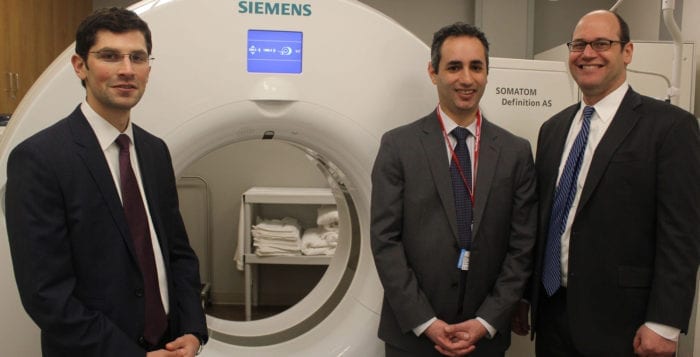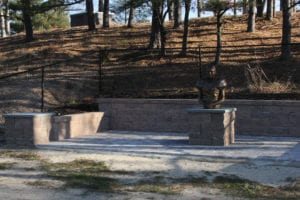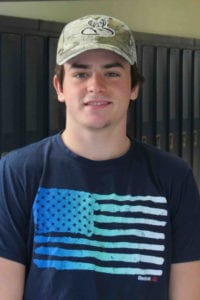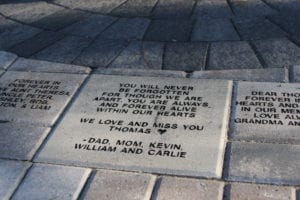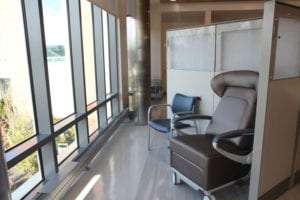By Kevin Redding
Residents of Smithtown and its surrounding neighborhoods now have easy access to quality radiologic care that eliminates the need for long and distressing hospital visits.
At Northwell Health Imaging at Smithtown, patients in need of a wide variety of diagnostic testing services including MRIs, low-dose CAT scans and ultrasounds are guaranteed the ease of a private practice with the expertise and equipment of an academic medical center.
The center, which took two years to build, provides 3D mammograms, bone density tests, digital X-rays and biopsies, all within a spa-inspired atmosphere that’s warm and comforting to its patients.
On Dec. 8, a ribbon cutting was held in the lobby of the $2.8 million facility — even though it officially opened to the public in early September. Northwell Health’s staff, local medical community members and dignitaries gathered to celebrate the center, which stands as the fourth imaging center in Suffolk County; the others are located in Huntington, Bay Shore and Islip.
“It’s convenient and far more patient-friendly and structured here … access is easier.”
—David Seligman
David Seligman, vice president of imaging services at Northwell Health, said radiology has become a much more community-based service and there isn’t much of a need anymore to go to the hospital for a brain scan, chest scan or mammogram. He said the quality of care at the center is just as good as it is in the best hospitals, but the experience for the patient is far better, especially in terms of scheduling and predictability.
“It’s convenient and far more patient-friendly and structured here … access is easier,” Seligman said at the ribbon cutting. “The environment obviously is intended to be spa-like; it’s quiet, inviting, private. We try to get patients in and out so they don’t have to waste an entire day coming in for a CT study [for instance]. The response to these community-based practices is far more positive in the general population.”
He said he’s excited because he knows patients who come to the center are going to have a high-quality and efficient experience.
Dr. Jesse Chusid, senior vice president of imaging services and a diagnostic radiologist said Northwell Health wanted to offer an alternative to the hassles associated with a hospital.
“When you go to a hospital, the parking isn’t very good, you have to walk through a giant building that’s complicated, signage is not always optimal and you’re in a place with a lot of sick patients,” Chusid said. “It’s not always a comfortable setting to be in when you’re a well person just going for a checkup, so I think you get to avoid all that by coming to an outpatient facility like this one. Everybody likes the way this facility is laid out; it’s comfortable for people. When you’re coming in for health care, it’s anxiety producing, everybody is always worried when they walk in the door so if you have an environment that’s warm and welcoming with people who can comfort then it makes the whole experience a lot easier and that’s what we have here.”
He said Northwell Health has Long Island’s largest group of fellowship-trained, subspecialized radiologists in its health system — upwards of 170, although only two will be at the center day to day, one more focused on general kinds of imaging and the other on women’s imaging and breast health.
The large group of radiologists across the system allows for focused expertise on specific problems patients might have. By interpreting and studying results in their specialized fields, the radiologists have proven to make more accurate diagnoses.
“The whole goal is to make it easy and convenient for patients to get the imaging they need and then route those images to somebody who’s uniquely trained to be able to give an expert interpretation.”
—Jesse Chusid
Even though not all the experts are in the building, if an imaging is done, it can be immediately shared with other radiologists in their network with the technology to which they have access.
“The whole goal is to make it easy and convenient for patients to get the imaging they need and then route those images to somebody who’s uniquely trained to be able to give an expert interpretation,” Chusid said.
He said the center invests a lot in newer technology and plans to keep doing so.
“The direction not just in radiology but in all of health care is toward telemedicine, and providing services remotely, which makes for more convenient access for patients and allows you to spread out subspecialized resources over a big network like this,” the senior vice president said. “By making a virtual network, you can get those images everywhere.”
The facility contains the sort of equipment found in major hospitals, like their CT scan, which is sleeker and less claustrophobic than most. While some scans have more depth and seem to encase anybody inside it, the one available at the center is much more open and patient-friendly.
Chusid said mammographers can take 3D images in breast cancer screenings to better detect early phases of cancer and get treatment started at a quicker pace.
The radiologists are also trained to perform minimally invasive surgical procedures. If a scan is performed and they notice something in the liver or thyroid gland, for example, they can do a biopsy with a needle and send that tissue to a pathologist to get a definitive answer on what it is.
Dr. Jason Naidich, chairman of the Radiology Department at Northwell Health, said having this high level of equipment in the local community is great for patients.
“It means they don’t have to travel to a big academic medical center to get this level of care,” Naidich said. “In radiology, the quality of the service you get is based largely on the equipment that is used. We also try to make it as convenient as possible for patients, so we have extended hours … evening hours, weekend hours. It’s important to make sure we’re accessible to patients who work during the day.”




 East Setauket: Ward Melville High School student-actors and musicians recently dazzled audiences when they took to the stage to perform the Tony Award-winning musical “Sweeney Todd.” The story tells the tale of a famed barber who returns to work above a struggling pie shop under an alias after being wrongly sentenced to life. Working with the baker, Mrs. Lovett, the pair seek vengeance against the corrupt judge who sentenced Todd and end up traveling down a path with deadly consequences. From the opening number, the cast impressed the packed audiences and kept them entertained until the final curtain call.
East Setauket: Ward Melville High School student-actors and musicians recently dazzled audiences when they took to the stage to perform the Tony Award-winning musical “Sweeney Todd.” The story tells the tale of a famed barber who returns to work above a struggling pie shop under an alias after being wrongly sentenced to life. Working with the baker, Mrs. Lovett, the pair seek vengeance against the corrupt judge who sentenced Todd and end up traveling down a path with deadly consequences. From the opening number, the cast impressed the packed audiences and kept them entertained until the final curtain call.